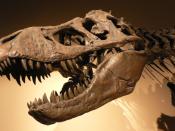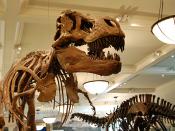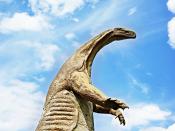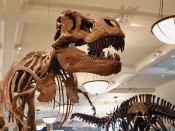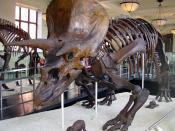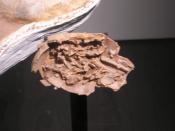Right now, it's impossible to recreate extinct dinosaurs. It is pretty unlikely that scientists will ever be able to bring them back to life. Only with a quantum leap in scientific comprehension could such a project be successful. However, technology is advancing every day, and everyday we are getting closer to that dim light at the end of the tunnel that is recreating extinct dinosaurs and bringing to life the famed "Jurassic Park". However, just like anything else, it will take time and certain procedures to achieve the seemingly impossible task.
The first step is to find dinosaur DNA. New technology has made research on fossil DNA possible, but no dinosaur DNA has ever been found. At the American Museum of Natural History, researchers have extracted the sequenced DNA from a weevil that lived 25 to 40 million years ago, long after the end of the age of dinosaurs, but that's the closest they've come.
Other scientists have found fossil DNA from other insects and plants. The most common way to find the DNA is in mosquitoes that had bitten living dinosaurs. Soon afterward, these insects were caught in oozing tree sap that fossilized into amber. The scientists in the movie extracted dinosaur blood from the fossilized insects and used the DNA in the blood to recreate dinosaurs. However in real life, it is extremely hard to extract DNA from these mosquitoes. And even if the DNA was extracted, it's even harder to tell what kind of species' of DNA you have. The DNA is hard to read because there is no "Dinosaur Genome" reference, and even if there was, it's hard to read because the DNA might be "chopped" (there are many missing pieces of it).
The second step would be to grown an embryo. If it is considered hard to find Dinosaur DNA, then it can be justifiably considered near impossible to grow an embryo. Now, while there are listed procedures on how someone would go about duplicating "Jurassic Park", there are none for how someone would go about growing and dinosaur embryo. It is uncharted territory in this field of genetic engineering. However, scientists have provided what they feel would be, with all the right materials and of course, a little bit of luck, a successful propagation. First, you would need to inject the dinosaur's DNA into a cell, then insert that into an ostrich egg. The reason they picked the ostrich is because its genetic coding seems to be the most alike. When the ostrich would be born, it would bare dinosaurian features, scientists could then compare this ostrich's DNA with a hybrid ostrich's and pinpoint what coding constitutes what features. By repeating this process a number of times, scientists could eventually construct a whole dinosaur, in theory, that is. But the conundrum remains of how would the dinosaur's DNA react with that of the ostrich. The only answer scientists could come up with would be to eliminate the ostrich's DNA altogether.
The third step in the process of resurrecting dinosaurs from the past is to raise the baby. Now, obviously dinosaurs were, relatively, very large creatures. They also had short life spans. This can show us that they have a higher growth rate. You could find out the exact growth rate by looking at its blood cells. So we can guess that it would be very easy for that baby to grow into a full-sized adult. As a result, the egg would have to be monitored carefully. This kind of monitoring is unconventional, and, as a result, would probably taint the dinosaur's life-style, altering it from it's natural course.
The fourth step is to choose a habitat. By studying what kinds of areas have the largest concentration of dinosaur fossils, paleontologists have devised that the ambient factors and conditions of tropical islands would be prime for the new home of the dinosaur. However, because accessibility and space would be limited, scientists have ruled out islands as an option. However, two cities in California, Los Angeles and San Diego, have been found to be prime locations for the rehabilitation place of the dinosaur. The dinosaurs, like cattle, would have to be kept in herds, this way, they could be maintained more easily while being able to consort with one another.
The fifth step is to plan a diet. There are more complications to this contention than one might think, and, seeing as how it's such a crucial part of living, there is no room for error. The first step in planning a diet is to find out what that diet might consist of. To do this, scientists have analyzed fossilized dung to find remnants of different species of plants and animals that might have served as the dinosaur's food. The second step is to acquire that food. Now, seeing as how some of that food might be extinct, it would make it particularly hard to acquire this food. Substituting could be dangerous. Now, another aspect of planning the diet would be to recognize the means of getting this food. Carnivores particularly, have a natural instinct to hunt, not to be fed. They are, by nature, predators, they need to stalk their prey just as much as they need to eat it. Providing the proper medium for which stalking would be executed could be tricky. As far as vegetarians go, there needs to be a place where the proper plants and such could be grown where they wouldn't interfere with the eco-system.
The sixth and final step in bring the dinosaur back to life is to manage the animals. If we managed to raise this baby and provide it with a sufficient diet, we would then have the monumental task of keeping it alive - it would be living in a world full of germs and other dangers to which it had no resistance. Our world is empty of the food and environment that dinosaurs were used to. Even on a tropical island, dinosaurs would sicken and die eventually. Our world has changed a lot in 65 million years. So the question is posed as to how we should manage these animals. Scientists have not been able to come up with a generally accepted plausible means of doing this. And we have to face the facts that no matter what we do to "manage" them, it won't be natural, therefore, we will not have brought back the dinosaur, rather, we will have taken nature, reversed it, then mutilated it to the point beyond recognition. Clearly this is a step out of line and needs to be avoided at all costs.
So, in summary, if we could find perfectly preserved dinosaur DNA, extract and sequence it with little error, organize it into chromosomes, place it into the living egg of the correct species, and raise the egg successfully, then I suppose we could all have pet Triceratops. However this blatantly unnecessary novelty must be avoided as how it defies nature at many levels and it would be unethical in the eyes of many.
